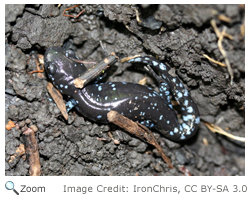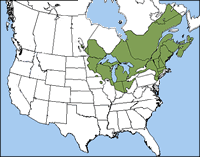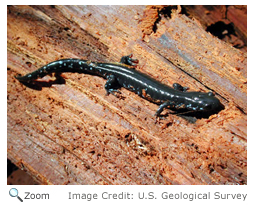Description
 The blue-spotted salamander is a slender salamander, three to five inches in length, with a long tail. It is gray to blue -black with blue spots on its sides, tail, and legs. Its belly is lighter than its back. It has four toes on its front feet and five toes on its rear feet. It has 12 costal grooves (vertical grooves) on its body. The blue-spotted salamander is a slender salamander, three to five inches in length, with a long tail. It is gray to blue -black with blue spots on its sides, tail, and legs. Its belly is lighter than its back. It has four toes on its front feet and five toes on its rear feet. It has 12 costal grooves (vertical grooves) on its body.
Range  The blue-spotted salamander is found in the eastern central United States and Canada east to the Atlantic provinces in Canada and northern New England and in the Great Lakes region.
The blue-spotted salamander is found throughout New Hampshire. The blue-spotted salamander is found in the eastern central United States and Canada east to the Atlantic provinces in Canada and northern New England and in the Great Lakes region.
The blue-spotted salamander is found throughout New Hampshire.
Habitat
The blue-spotted salamander lives in deciduous and coniferous forests. It likes places with moist soil and small ponds. It often takes shelter in burrows or under damp leaves, moss, or logs.
Diet
The blue-spotted salamander eats a wide variety of insects along with small invertebrates like slugs, earthworms, spiders, snails, and centipedes. |
|
Life Cycle  In early spring, the blue-spotted salamander migrates to vernal ponds. Males arrive first. Vernal ponds make good breeding grounds. Vernal ponds are temporary ponds that form in the spring when the snow melts. Vernal ponds or pools eventually dry out. This prevents predators that might eat the salamanders, like fish and frogs, from establishing themselves in the pond. The male holds the female with his front legs and rubs his chin on her head. He then deposits spermatophore (a packet of sperm) on the pond bottom. Next, he tries to position the female over the sperm. If all goes well, she takes the sperm in and it fertilizes her eggs. In early spring, the blue-spotted salamander migrates to vernal ponds. Males arrive first. Vernal ponds make good breeding grounds. Vernal ponds are temporary ponds that form in the spring when the snow melts. Vernal ponds or pools eventually dry out. This prevents predators that might eat the salamanders, like fish and frogs, from establishing themselves in the pond. The male holds the female with his front legs and rubs his chin on her head. He then deposits spermatophore (a packet of sperm) on the pond bottom. Next, he tries to position the female over the sperm. If all goes well, she takes the sperm in and it fertilizes her eggs.
The female lays her eggs on the pond bottom. The eggs are attached to plants, rocks, logs, or debris. Salamander larvae hatch in two to four weeks. They have external gills and no legs. Over time, legs develop and they lose their external gills. While they are in their larval stage, they eat small crustaceans, worms, and insects. The time it takes them to transform from a larvae to a salamander varies depending on how much food is available.
Behavior
The blue-spotted salamander is very secretive and usually only comes out from cover at night and during damp or rainy weather. It has glands on its tail that produces a milky toxin that it secretes when it is threatened. If a predator attacks, it curls its tail over its body and releases the toxin into the predator's mouth!
|


 The blue-spotted salamander is found in the eastern central United States and Canada east to the Atlantic provinces in Canada and northern New England and in the Great Lakes region.
The blue-spotted salamander is found throughout New Hampshire.
The blue-spotted salamander is found in the eastern central United States and Canada east to the Atlantic provinces in Canada and northern New England and in the Great Lakes region.
The blue-spotted salamander is found throughout New Hampshire.
